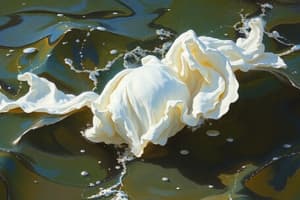Podcast
Questions and Answers
What determines whether an object will float or sink in a fluid?
What determines whether an object will float or sink in a fluid?
- The temperature of the fluid
- The shape of the object
- The density of the object relative to the fluid (correct)
- The volume of the fluid displaced
How does the density of gases change with increasing pressure?
How does the density of gases change with increasing pressure?
- It is negligible as gases are incompressible
- It increases due to compression (correct)
- It decreases due to expansion
- It remains constant regardless of pressure
Which of the following statements about hydrostatic pressure is correct?
Which of the following statements about hydrostatic pressure is correct?
- Hydrostatic pressure is determined by the shape of the container.
- Hydrostatic pressure only applies to gases.
- Hydrostatic pressure is calculated as P = ρgh. (correct)
- Hydrostatic pressure decreases with depth in a fluid.
Which of the following methods best determines the density of an irregular object?
Which of the following methods best determines the density of an irregular object?
What is the primary reason that water becomes less dense when frozen?
What is the primary reason that water becomes less dense when frozen?
Flashcards
Buoyancy
Buoyancy
The upward force a fluid exerts on a submerged object.
Archimedes' Principle
Archimedes' Principle
The buoyant force acting on a submerged object equals the weight of the fluid displaced by the object.
Density
Density
The amount of matter packed into a given volume.
Hydrostatic Pressure
Hydrostatic Pressure
Signup and view all the flashcards
Density of a Solution
Density of a Solution
Signup and view all the flashcards
Study Notes
Pressure and Density
Buoyancy
- Buoyancy is the upward force exerted by a fluid on an object submerged in it.
- Archimedes' Principle: An object submerged in a fluid experiences a buoyant force equal to the weight of the fluid displaced by the object.
- Factors affecting buoyancy:
- Volume of the object
- Density of the fluid
- Density of the object
- An object will float if its density is less than that of the fluid, and it will sink if its density is greater.
Density Variations
- Density is defined as mass per unit volume (Density = Mass/Volume).
- Variation with temperature:
- Generally, liquids and gases decrease in density as temperature increases.
- Water is an exception; it reaches maximum density at 4°C and becomes less dense when frozen.
- Variation with pressure:
- Incompressible fluids (e.g., liquids) show little density change with pressure.
- Gases compress under pressure, increasing density with decreasing volume.
Pressure Calculations
- Pressure (P) is defined as force (F) applied per unit area (A):
- P = F/A
- Units: Commonly measured in Pascals (Pa), atmospheres (atm), or bar.
- Hydrostatic pressure: The pressure exerted by a fluid at rest due to the weight of the fluid above:
- P = ρgh
- ρ = density of the fluid
- g = acceleration due to gravity (approx. 9.81 m/s²)
- h = height of the fluid column
- P = ρgh
Density Calculations
- To calculate density:
- Density (ρ) = Mass (m) / Volume (V)
- Common methods of determining density:
- Using a balance to measure mass and a graduated cylinder or volumetric flask for volume.
- For irregular objects, use displacement method: measure the volume of water displaced when the object is submerged to find its volume.
- Density of a solution can be calculated using the mass of solute and the total volume of the solution.
Buoyancy
- Buoyancy refers to the upward force a fluid exerts on a submerged object.
- Archimedes' Principle states that the buoyant force equals the weight of the fluid displaced by the submerged object.
- Key factors that influence buoyancy include:
- The volume of the object: larger volumes displace more fluid.
- The density of the fluid: denser fluids exert greater buoyant forces.
- The density of the object: if the object's density is lower than that of the fluid, it will float; if higher, it sinks.
Density Variations
- Density is calculated by the formula: Density = Mass / Volume.
- Temperature effects:
- Liquids and gases generally have decreasing density with increased temperature.
- Water is unique; it reaches maximum density at 4°C and becomes less dense when frozen.
- Pressure effects:
- Incompressible fluids (usually liquids) show minimal change in density under increased pressure.
- Gases become denser as pressure increases and volume decreases.
Pressure Calculations
- Pressure (P) is defined as Force (F) divided by Area (A): P = F/A.
- Units of pressure include Pascals (Pa), atmospheres (atm), and bar.
- Hydrostatic pressure is the pressure at a fluid's rest, determined by the weight of the fluid above:
- P = ρgh, where:
- ρ = fluid density
- g = acceleration due to gravity (approximately 9.81 m/s²)
- h = height of the fluid column.
- P = ρgh, where:
Density Calculations
- Density can be computed using the formula: Density (ρ) = Mass (m) / Volume (V).
- Common approaches to measuring density include:
- Balancing the object's mass and using a graduated cylinder for volume measurement.
- For irregularly shaped objects, apply the displacement method: measure the water displacement when submerged.
- Solution density can be calculated using the mass of the solute divided by the total volume of the solution.
Studying That Suits You
Use AI to generate personalized quizzes and flashcards to suit your learning preferences.




